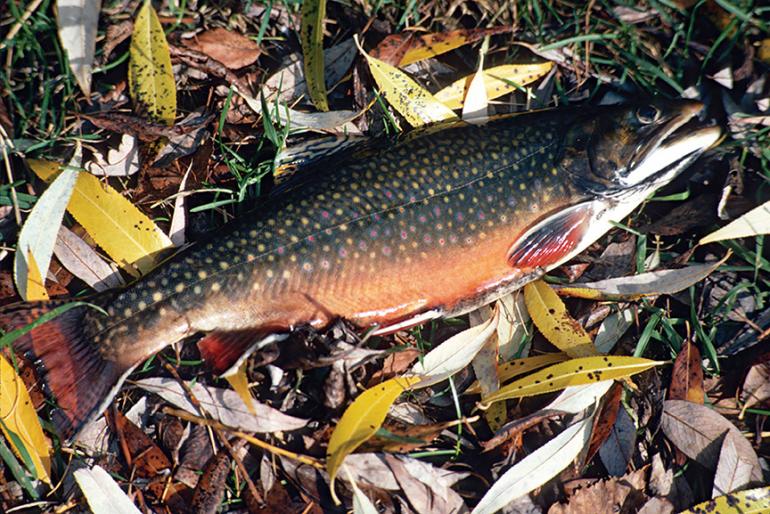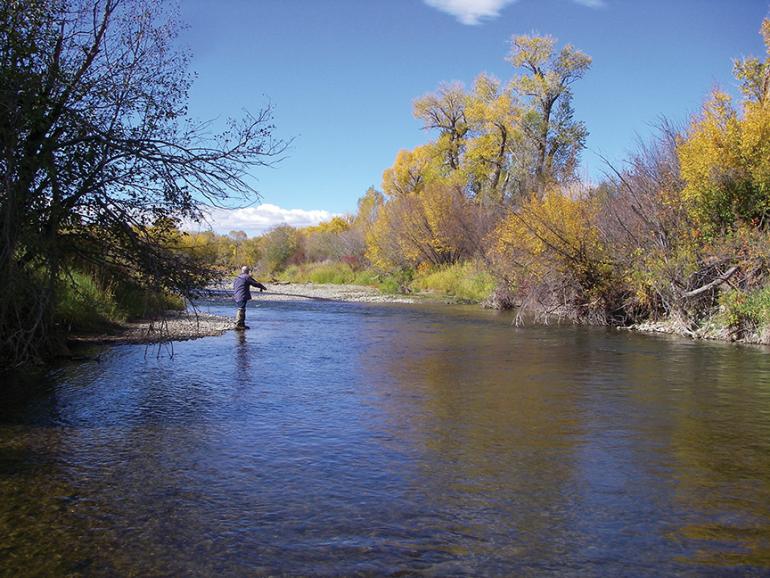Flashy Fish
Fall's prismatic brook trout.
Come early autumn, I reflexively turn to streamer fishing, but as the season moves along, hunting large, secretive, predatory browns somehow gives way to searching out brook trout. Brookies are beautiful fish any time of the year, but by September and October, their coloration intensifies to the point that “riot of color” becomes an understatement. In streams where a foot-long specimen was a big one in summer, fish exceeding 15 inches are on the move, chasing late-season grasshopper imitations, fall caddis ties, and streamers like marabou muddlers, blacknose dace, and woolly buggers. Gone is the hunkering down in the darkness of undercut banks; active feeding is underway.
Like browns and rainbows, brook trout are not native. They were introduced in 1889 from the eastern part of the continent and thrive in cool, clear, pure headwater streams. Though attempts are made to remove brookies from streams where native species like Yellowstone and westslope cutthroat live, the fish is a hardy one, and once established, difficult to eradicate.
One late-September afternoon—partly cloudy, mid-60s, light breeze—on a stream flowing out of the Absaroka Mountains, I casted a #14 Royal Wulff to runs, pockets, and pools that during the summer had yielded foot-long-at-most brookies. On the second cast to the head of a dark pool, swirling with cold water from a bankside seam, the fly landed in the foam, swirled a bit, and was engulfed by a fish that was clearly more than I was used to here. My line tightened and the trout whirled around along the bottom, lost from view. Maybe a minute later, a brook trout of 16-17 inches slashed the water’s surface, its struggle creating crimson, deep-blue, emerald, and light-blue spotting, surrounded by silver halos. Brought to my feet, he displayed the kype of a mature male near spawning velocity. The hooked, under-slung jaw was striking, as was the girth of the bright fish. I turned him loose with a slight twist of the hook, then caught two more in the run that fed the pool. Both were smaller, but still 15 inches—all three larger and more colorful than any I’d caught during warmer months in years past.
Out of curiosity, I tied on a #10 marabou muddler, weighted with wraps of wire, and worked it through the bottoms of runs and pools. More fat, feisty brookies in the same size range hit the pattern with spirit and alacrity. As I worked upstream, the shafts of sunlight tinted green by pines, I enticed fish on small hopper patterns and even on partridge and orange soft-hackles swung from the ends of riffles into deeper water.
The day was glorious—the fishing, the stream, the weather, the aspens going gold on the hillsides to the north of me. After several hours, I’d caught and released 15 to 20 brook trout that averaged over a foot—that first brookie was the largest. All of them were intensely colored, thick, healthy fish.
The only angling skill needed was a somewhat accurate 25-foot cast. A six-foot-six-inch four-weight rod worked fine and played the fish sportingly yet quickly so they were all returned to the stream tired, but not exhausted. A modicum of stealth was required—less than needed for browns, but about the same as necessary for carefree cutthroat. A leader of nine-feet tapered to 4x is ideal, and even 7.5 feet works well.
In recent years I’ve had similar experiences on similar waters. Cold headwaters or small meadow streams are the objects of my attention. Sometimes Yellowstone cutthroat or even one of those elusive browns we fly fishers cherish jumps into the brook trout parade. The partly cloudy, cool-to-warm days of September and October are glorious, some of the finest times of the year. They are made all the more so by the prismatic splendor and wildness of brook trout.
John Holt is the author of 21 books including The Lost Patrol, Fly Fishing Montana Death in a Live Forest and Where Paradise Lay.








